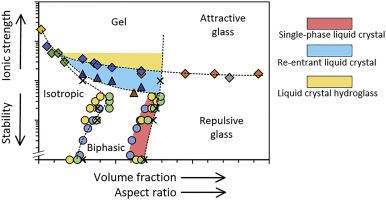当前位置:
X-MOL 学术
›
Adv. Colloid Interface Sci.
›
论文详情
Our official English website, www.x-mol.net, welcomes your
feedback! (Note: you will need to create a separate account there.)
A review of nanocrystalline cellulose suspensions: Rheology, liquid crystal ordering and colloidal phase behaviour.
Advances in Colloid and Interface Science ( IF 15.9 ) Pub Date : 2019-11-19 , DOI: 10.1016/j.cis.2019.102076 Yuan Xu 1 , Aleks Atrens 2 , Jason R Stokes 1
Advances in Colloid and Interface Science ( IF 15.9 ) Pub Date : 2019-11-19 , DOI: 10.1016/j.cis.2019.102076 Yuan Xu 1 , Aleks Atrens 2 , Jason R Stokes 1
Affiliation

|
Nanocrystalline cellulose (NCC) is a colloidal rigid rod, referred to by various terms in the literature including cellulose whisker (CW) and cellulose nanocrystal (CNC). These charged colloidal rods exhibit complex colloidal phase and rheological behaviours in aqueous suspensions, that are dependent on volume fraction and interparticle forces. A major shortcoming in the literature of NCC is that the dimensions and morphology of NCC particles vary significantly with the type of raw material and manufacturing conditions, which causes inconsistencies in suspension rheology and colloidal behaviours reported between different works. In this review, we consider the theory and experimentally-determined rheological and colloidal phase behaviours of charged rod suspensions in general, with a focus in particular on NCC. Dilute and semi-dilute NCC suspensions are isotropic liquids, in which NCC particles follow diffusional dynamics. The rheology of these isotropic NCC suspensions can be described by theoretical models that account for the effects of rod dimensions and surface charge, including those based on Doi and Edwards' theory. With increasing NCC concentration, the isotropic phase can undergo a transition to a liquid crystalline state (isotropic-nematic transition) or a transition to a dynamically arrested solid (liquid-solid transition). The liquid crystal ordering and gelation/glass transition are of particular interest because they respectively form an ordered structure and allow a solid-like mechanical response at relatively low solids fraction. For conditions at which the isotropic-nematic and liquid-solid transitions coincide, the formation of an anisotropic structure within a soft solid suspension is possible. Investigation of these two competing transitions led to the discovery of liquid crystal re-entrancy and existence of an anisotropic soft solid (liquid crystal hydroglass, LCH). LCH has a biphasic structure with an attractive glass matrix and a co-existing liquid crystal phase, providing similar viscoelastic properties to hydrogels but permitting reversible orientation of the colloidal rods in the liquid crystalline phase by shear forces; i.e. their structural ordering is programmable. The liquid crystal transition and gelation/glass transitions are quantitatively dependent on rod dimensions i.e. respectively proportional to L2D and L/D. Phase transitions in NCC suspensions including liquid crystal re-entrancy and formation of LCH can be fully described as a function of rod dimension, volume fraction and interparticle forces. This behaviour is independent of NCC source, allowing development of a generalised phased diagram in which separately-reported phase transitions converge to consistent phase boundaries. This validates a key hypothesis for the study of NCC suspensions, that variation in NCC concentration and interparticle forces can explain the complex phase behaviours observed within suspensions formulated using NCC obtained from different sources.
中文翻译:

纳米晶纤维素悬浮液的综述:流变学,液晶有序性和胶体相行为。
纳米晶纤维素(NCC)是一种胶体刚性棒,在文献中用各种术语指称,包括纤维素晶须(CW)和纤维素纳米晶(CNC)。这些带电的胶体棒在水性悬浮液中表现出复杂的胶体相和流变行为,这取决于体积分数和颗粒间作用力。NCC文献的一个主要缺点是NCC颗粒的尺寸和形态随原材料的类型和制造条件的不同而有很大差异,这导致了不同工作之间报道的悬浮液流变学和胶体行为的不一致。在这篇综述中,我们通常考虑带电棒悬浮液的理论以及由实验确定的流变和胶体相行为,尤其是NCC。稀和半稀NCC悬浮液是各向同性液体,其中NCC颗粒遵循扩散动力学。这些各向同性NCC悬浮液的流变学可以通过理论模型来描述,这些模型考虑了棒尺寸和表面电荷的影响,包括基于Doi和Edwards理论的影响。随着NCC浓度的增加,各向同性相可能经历向液晶态的转变(各向同性向列相转变)或向动态滞留的固体转变(液固转变)。液晶有序化和凝胶化/玻璃化转变是特别令人感兴趣的,因为它们分别形成有序的结构,并在相对较低的固体分数下产生类固体的机械响应。对于各向同性向列和液固转变同时发生的条件,在软固体悬浮液中形成各向异性结构是可能的。对这两个相互竞争的跃迁的研究导致发现液晶可重入并存在各向异性的软固体(液晶水玻璃,LCH)。LCH具有两相结构,具有吸引人的玻璃基质和共存的液晶相,提供与水凝胶相似的粘弹性质,但通过剪切力允许胶体棒在液晶相中可逆取向;即它们的结构顺序是可编程的。液晶转变和凝胶化/玻璃化转变在定量上取决于棒的尺寸,即分别与L2D和L / D成比例。NCC悬浮液中的相变(包括液晶重入和LCH的形成)可以完全描述为棒尺寸,体积分数和粒子间作用力的函数。此行为独立于NCC来源,从而允许开发广义相图,其中单独报告的相变收敛于一致的相界。这证实了NCC悬浮液研究的关键假设,即NCC浓度和颗粒间作用力的变化可以解释使用从不同来源获得的NCC配制的悬浮液中观察到的复杂相行为。允许开发通用相图,其中单独报告的相变收敛到一致的相界。这证实了NCC悬浮液研究的关键假设,即NCC浓度和颗粒间作用力的变化可以解释使用从不同来源获得的NCC配制的悬浮液中观察到的复杂相行为。允许开发广义相图,其中单独报告的相变收敛到一致的相界。这证实了NCC悬浮液研究的关键假设,即NCC浓度和颗粒间作用力的变化可以解释使用从不同来源获得的NCC配制的悬浮液中观察到的复杂相行为。
更新日期:2019-11-20
中文翻译:

纳米晶纤维素悬浮液的综述:流变学,液晶有序性和胶体相行为。
纳米晶纤维素(NCC)是一种胶体刚性棒,在文献中用各种术语指称,包括纤维素晶须(CW)和纤维素纳米晶(CNC)。这些带电的胶体棒在水性悬浮液中表现出复杂的胶体相和流变行为,这取决于体积分数和颗粒间作用力。NCC文献的一个主要缺点是NCC颗粒的尺寸和形态随原材料的类型和制造条件的不同而有很大差异,这导致了不同工作之间报道的悬浮液流变学和胶体行为的不一致。在这篇综述中,我们通常考虑带电棒悬浮液的理论以及由实验确定的流变和胶体相行为,尤其是NCC。稀和半稀NCC悬浮液是各向同性液体,其中NCC颗粒遵循扩散动力学。这些各向同性NCC悬浮液的流变学可以通过理论模型来描述,这些模型考虑了棒尺寸和表面电荷的影响,包括基于Doi和Edwards理论的影响。随着NCC浓度的增加,各向同性相可能经历向液晶态的转变(各向同性向列相转变)或向动态滞留的固体转变(液固转变)。液晶有序化和凝胶化/玻璃化转变是特别令人感兴趣的,因为它们分别形成有序的结构,并在相对较低的固体分数下产生类固体的机械响应。对于各向同性向列和液固转变同时发生的条件,在软固体悬浮液中形成各向异性结构是可能的。对这两个相互竞争的跃迁的研究导致发现液晶可重入并存在各向异性的软固体(液晶水玻璃,LCH)。LCH具有两相结构,具有吸引人的玻璃基质和共存的液晶相,提供与水凝胶相似的粘弹性质,但通过剪切力允许胶体棒在液晶相中可逆取向;即它们的结构顺序是可编程的。液晶转变和凝胶化/玻璃化转变在定量上取决于棒的尺寸,即分别与L2D和L / D成比例。NCC悬浮液中的相变(包括液晶重入和LCH的形成)可以完全描述为棒尺寸,体积分数和粒子间作用力的函数。此行为独立于NCC来源,从而允许开发广义相图,其中单独报告的相变收敛于一致的相界。这证实了NCC悬浮液研究的关键假设,即NCC浓度和颗粒间作用力的变化可以解释使用从不同来源获得的NCC配制的悬浮液中观察到的复杂相行为。允许开发通用相图,其中单独报告的相变收敛到一致的相界。这证实了NCC悬浮液研究的关键假设,即NCC浓度和颗粒间作用力的变化可以解释使用从不同来源获得的NCC配制的悬浮液中观察到的复杂相行为。允许开发广义相图,其中单独报告的相变收敛到一致的相界。这证实了NCC悬浮液研究的关键假设,即NCC浓度和颗粒间作用力的变化可以解释使用从不同来源获得的NCC配制的悬浮液中观察到的复杂相行为。











































 京公网安备 11010802027423号
京公网安备 11010802027423号